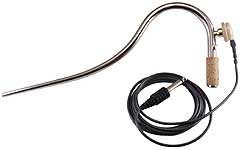When most people think of the bassoon (for those that are even aware that the bassoon exists), they associate it with classical music. Despite being thought of as the clown of the orchestra for many years, the bassoon has come out on top with an array of beautiful solo and orchestral repertoire. Between Stravinsky’s Rite of Spring, Tchaikovsky’s Symphony No. 4, Prokofiev’s Peter and the Wolf, Ravel’s Bolero, and Rimsky-Korsakov’s Scheherazade to name a few, the bassoon has established itself firmly in the orchestral canon. So what happens when you take an instrument that is rooted deeply in tradition and take it in the opposite direction to the point where it no longer even sounds like itself? Incredibly cool things happen, so much so that you’re going to want to interrupt your friends to show them a crazy YouTube video that they couldn’t fathom in their wildest dreams.
The concept of electric bassoon is a hard one to imagine if you have not had the privilege of witnessing one in person. Electric instruments became increasingly popular as a result of the rise of rock and roll. The electric guitar developed in the 40s and 50s, quickly making its way into popular music. This use in a popular setting created a divide amongst guitarists, some delighted by the new possibilities, and some horrified by the changes. Gavin Carfoot explores this reaction to the evolution of guitar technology in his article “Acoustic, Electric and Virtual Noise: The Cultural Identity of the Guitar.” No in-depth studies have been published about this in regards to bassoon, as electric bassoon is a fairly recent and significantly less popular invention, but the same controversy exists. There are bassoonists who think that electric bassoon is the greatest thing to happen to the instrument, and some who view it as a disgrace. Of course, there exists a middle ground of those who are intrigued, but not quite sure what to do with it, or how viable a career path it presents.
One of the biggest differences between an electric guitar or violin and an electric bassoon is that the former are separate instruments from their acoustic counterparts. They are designed specifically to be electric instruments. This is not the case with electric bassoon. The part that makes electric bassoon “electric” is a special bocal with a pickup attached. Bassoons are comprised of four wooden joints, a metal bocal, and a reed. The bocal is curved, and traditionally has a hole that can be covered with the whisper key in order to change octaves. In order to make a bassoon electric, one must purchase a special bocal with a pickup microphone in it (or sacrifice one of their own bocals for the cause). The bocal has an adapter installed with the pickup, which attaches to a preamp and can then be used with various amps and pedals just like an electric guitar would. Forrests Music, a California-based specialty double reeds store, sells these bocals with pickups, as well as separate pickups, fondly known as “little jakes.”
Once the electric bassoon became an option, composers began composing for it. Perhaps the most famous piece for electric bassoon, Axeman by Anna Meredith allows bassoonists to live out any life-long dreams of becoming rock gods. The bassoon is routed through a guitar distortion pedal, giving it a gritty, harsh sound that is oddly similar to the electric guitar. Combining the sonic qualities with virtuoso runs, Meredith has created a piece that grants bassoonists the opportunity to do what can only be qualified as sweet, sweet shredding. So who knows…maybe in twenty years bassoonists will be fronting rock bands.
Here’s a video of Jeffrey Lyman, Associate Professor of Bassoon at the University of Michigan, rocking out on Axeman.
Carfoot, Gavin. “Acoustic, Electric and Virtual Noise: The Cultural Identity of the Guitar.” Leonardo Music Journal Vol. 16, Noises Off: Sound Beyond Music (2006): 35 – 39.


This is my favorite thing ever!
LikeLike
I will show this to everyone. Except my bassoonist roommate. Lest I arrive home to find this amp setup.
LikeLike